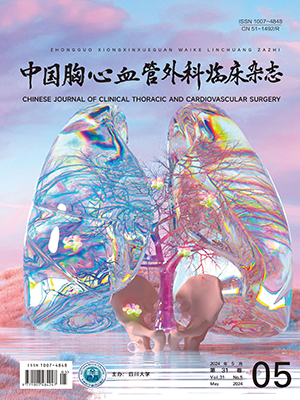Abstract: Objective To evaluate clinical outcomes of endoscopic vein harvesting (EVH)for coronary artery bypass grafting(CABG) in diabetic patients. Methods In this prospective non-randomized control study, patients with type 2 diabetes who underwent CABG from December 2010 to Febuary 2012 in West China Hospital were enrolled. Based on different vein graft harvesting technique, these patients were divided into two groups: an EVH group and a conventional vein harvesting(CVH)group. Perioperative complications were compared between the two groups. Interventional or CT coronary angiogram was used to evaluate bypass graft patency during follow-up. Results A total of 51 patients with type 2 diabetes were enrolled in this study with 24 patients in the EVH group and 27 patients in the CVH group. There was no statistical difference in age, weight, and comorbidities between the two groups. There was no statistical difference in cardiopulmonary bypass time and aortic cross-clamping time between the two groups (67.2±9.8 min versus 68.3±14.5 min, P>0.05; 62.4±11.3 min versus 65.2±10.3 min, P> 0.05). The vein graft harvesting time (35.6±6.4 min versus 45.2±11.4 min, P< 0.05)and rate of delayed leg wound healing(0.0% with 0/24 versus 18.5% with 5/27, P<0.05) of the EVH group were significantly shorter or lower than those of CVH group.There was no statistical difference in major postoperative complications with respect to venous graft failure rate and chest pain during short term follow-up(9.1 months in the CVH group and 9.4 months in the EVH group) between the two groups. Conclusion EVH is a safe, effective, minimally invasive and quick vein graft harvesting technique for CABG in diabetic patients.
Citation: MENG Wei,ZHU Da,XIAO Zhenghua,et al.. Endoscopic Vein Harvesting in Diabetic Patients Undergoing Coronary Artery Bypass Grafting: A Prospective Controlled Trial. Chinese Journal of Clinical Thoracic and Cardiovascular Surgery, 2012, 19(3): 258-261. doi: Copy




